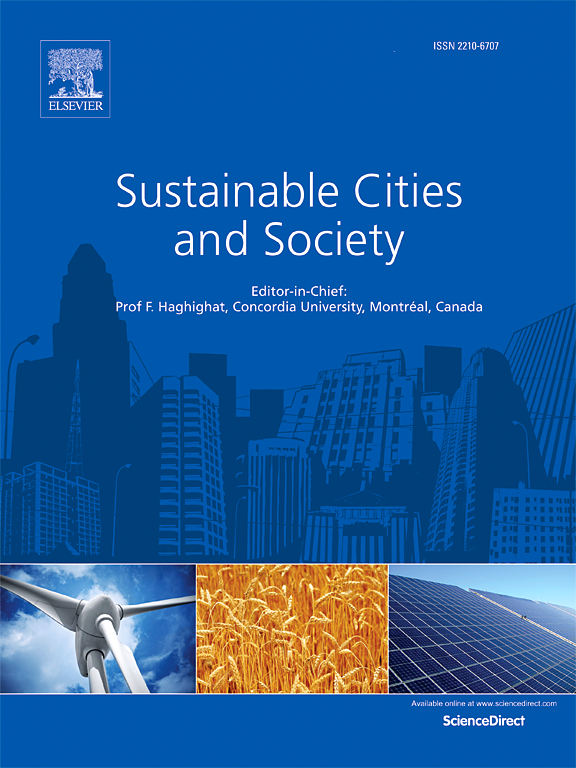Multilevel social vulnerability and urban health in sub-Saharan Africa: Implications for adaptation across household, community, and city levels
IF 10.5
1区 工程技术
Q1 CONSTRUCTION & BUILDING TECHNOLOGY
引用次数: 0
Abstract
As rapidly urbanizing settlements in sub-Saharan Africa face vulnerability to environmental hazards across spatial levels, understanding the multilevel structure of vulnerability is critical for advancing urban health and climate adaptation. This paper develops a conceptual framework to examine multilevel social vulnerability and its health impacts across cities in 28 African countries. By integrating household survey and spatial datasets, this study constructs vulnerability indicators at household, community, and city levels, employing principal component analysis to quantify social vulnerability at each level. Logistic regression models estimate the effects of vulnerabilities on child health outcomes, including under-five mortality, underweight, diarrhea, and acute respiratory infection (ARI). The analysis reveals substantial variations in vulnerabilities across the three spatial levels, each of which significantly impacts health. Household and community vulnerabilities are related to increased risks of underweight and diarrhea while household vulnerability is strongly associated with mortality. In large cities with populations over one million, the effects of city vulnerability become more pronounced across morbidity outcomes, particularly for severe ARI and diarrhea. These findings suggest that the health implications of vulnerabilities differ according to specific outcomes and urban settings, highlighting the importance of incorporating a multilevel perspective into urban health and adaptation planning.
撒哈拉以南非洲多层次社会脆弱性和城市卫生:对家庭、社区和城市各级适应的影响
由于撒哈拉以南非洲快速城市化的住区面临着跨空间层面的环境危害脆弱性,了解脆弱性的多层次结构对于促进城市健康和气候适应至关重要。本文开发了一个概念框架,以检查28个非洲国家城市的多层次社会脆弱性及其对健康的影响。本研究通过整合入户调查和空间数据集,构建了家庭、社区和城市三个层次的脆弱性指标,并采用主成分分析法对每个层次的社会脆弱性进行量化。Logistic回归模型估计脆弱性对儿童健康结果的影响,包括五岁以下儿童死亡率、体重不足、腹泻和急性呼吸道感染(ARI)。分析显示,三个空间层面的脆弱性存在巨大差异,每一个都对健康产生重大影响。家庭和社区脆弱性与体重不足和腹泻风险增加有关,而家庭脆弱性与死亡率密切相关。在人口超过100万的大城市中,城市脆弱性的影响在发病率结果中变得更加明显,特别是在严重急性呼吸道感染和腹泻方面。这些研究结果表明,脆弱性对健康的影响因具体结果和城市环境而异,突出了将多层次视角纳入城市健康和适应规划的重要性。
本文章由计算机程序翻译,如有差异,请以英文原文为准。
求助全文
约1分钟内获得全文
求助全文
来源期刊

Sustainable Cities and Society
Social Sciences-Geography, Planning and Development
CiteScore
22.00
自引率
13.70%
发文量
810
审稿时长
27 days
期刊介绍:
Sustainable Cities and Society (SCS) is an international journal that focuses on fundamental and applied research to promote environmentally sustainable and socially resilient cities. The journal welcomes cross-cutting, multi-disciplinary research in various areas, including:
1. Smart cities and resilient environments;
2. Alternative/clean energy sources, energy distribution, distributed energy generation, and energy demand reduction/management;
3. Monitoring and improving air quality in built environment and cities (e.g., healthy built environment and air quality management);
4. Energy efficient, low/zero carbon, and green buildings/communities;
5. Climate change mitigation and adaptation in urban environments;
6. Green infrastructure and BMPs;
7. Environmental Footprint accounting and management;
8. Urban agriculture and forestry;
9. ICT, smart grid and intelligent infrastructure;
10. Urban design/planning, regulations, legislation, certification, economics, and policy;
11. Social aspects, impacts and resiliency of cities;
12. Behavior monitoring, analysis and change within urban communities;
13. Health monitoring and improvement;
14. Nexus issues related to sustainable cities and societies;
15. Smart city governance;
16. Decision Support Systems for trade-off and uncertainty analysis for improved management of cities and society;
17. Big data, machine learning, and artificial intelligence applications and case studies;
18. Critical infrastructure protection, including security, privacy, forensics, and reliability issues of cyber-physical systems.
19. Water footprint reduction and urban water distribution, harvesting, treatment, reuse and management;
20. Waste reduction and recycling;
21. Wastewater collection, treatment and recycling;
22. Smart, clean and healthy transportation systems and infrastructure;
 求助内容:
求助内容: 应助结果提醒方式:
应助结果提醒方式:


